There are moments in a person’s life that one immediately knows one will remember forever. Every tiny little 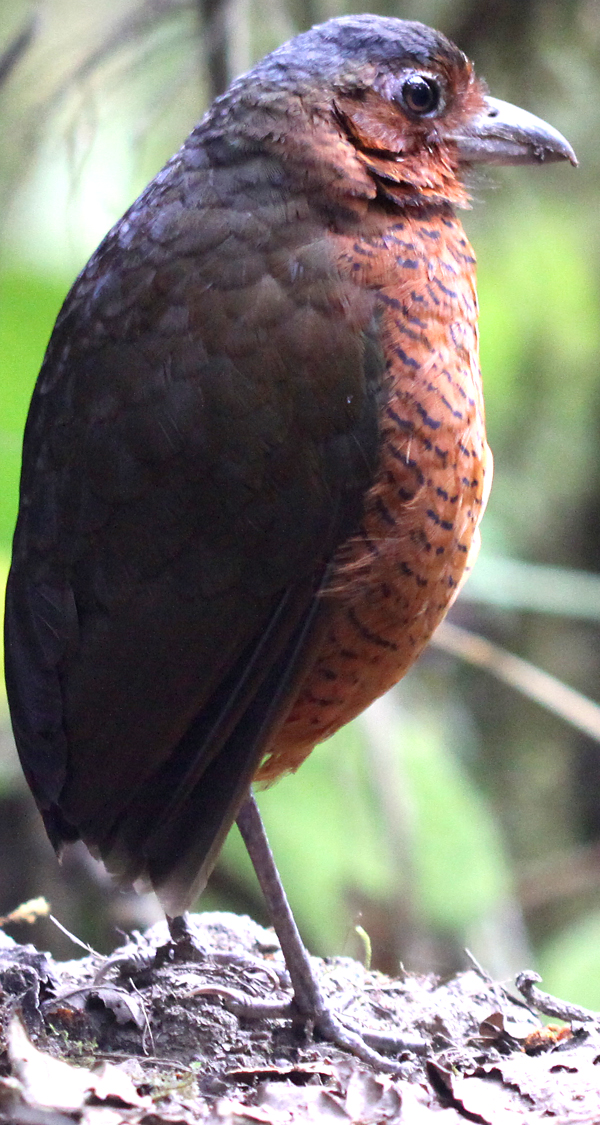 moment seems crystal clear when it happens but afterward it might seem like a blur. The loss of one’s virginity. Meeting the love of one’s life. The birth of a child. Hand-feeding a Giant Antpitta.
moment seems crystal clear when it happens but afterward it might seem like a blur. The loss of one’s virginity. Meeting the love of one’s life. The birth of a child. Hand-feeding a Giant Antpitta.
Wait. Hand-feeding a Giant Antpitta? How could I include such a trivial thing on a list of amazingly important moments? If you had ever hand-fed a Giant Antpitta you wouldn’t be asking such a question. For my justification and rationalization please keep reading. This really will make sense, I promise.
Refugio Paz de Las Aves is famous in birding circles as the best place in the world to see a Giant Antpitta. And we are not talking about any old antpitta here, but one Giant Antpitta in particular, the much-lauded and much-loved Maria. But how did this antpitta get recognized as an individual and become so famous? It is all thanks to a patient and kind man with the absolutely fitting name of Angel Paz.
The following is adapted from the Refugio Paz de las Aves website:
Back in the beginning of the 21st century Angel and his family, who had made their living logging, had plans for their property, and it did not include antpittas. They were going to log their cloudforest in northwestern 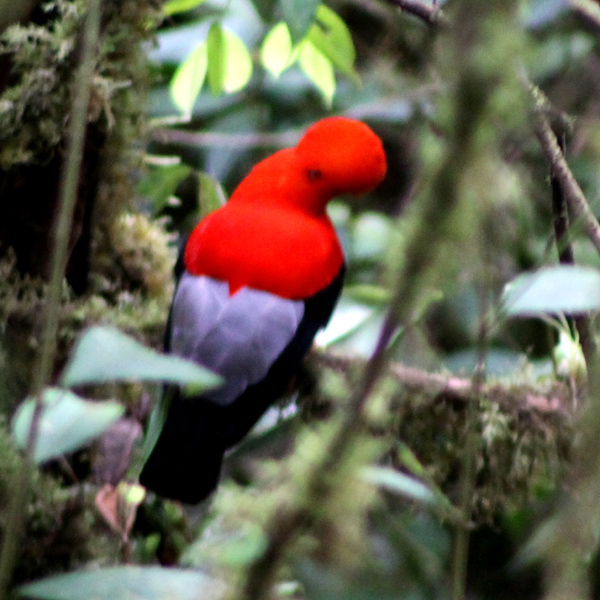 Ecuador and farm the land once the trees had been sold.
Ecuador and farm the land once the trees had been sold.
Fortunately Angel had a chance meeting with someone who let him know that tourists might like to see the bright orange birds, Andean Cock-of-the-Rock, that gathered at a lek in his forest to display to female cock-of-the-rock. Angel learned that if he constructed a good path to the lek people would pay to come see the birds! Of course, this sounded like a better way to live than chopping down the forest so Angel started building a trail. As he did, several of a tasty species of bird known as the Giant Antpitta would come out to the edge of the new trail and eat the worms exposed by the trail building. Angel briefly considered eating the antpittas but decided he would first find out if anyone wanted to see them. The answer was a resounding YES so he not only did not eat the antpittas but managed to get several individuals of different species trained to come to him in search of juicy, succulent worms. Maria, the Giant Antpitta, however, became and remains the star of the show.
Maria and Angel Paz
Why has Maria become famous? Antpittas in general are described in The Birds of Ecuador as “shy and elusive” and it is noted that they “are infrequently seen.” The Giant Antpitta in particular is described as “rare and seemingly local” and “normally elusive.” For such an infrequently seen species to be willing to not only be seen, but to put on a show, is astounding. Birders the world over, who have beat a trail to Rufugio Paz de las Aves, owe Angel Paz a debt of gratitude. Angel, on the other hand, knows to whom he owes his success, and he makes sure that Maria is well-fed and content.
Of course, with the great trails, hummingbird feeders, and quality habitat that Angel has preserved there are now many birders who visit Refugio Paz de las Aves to see not just antpittas and cocks-of-the-rock but a variety of tanagers, hummingbirds, barbets, quetzals, and a host of other species. Angel Paz, without aid from foundations or governments, managed to preserve a sliver of habitat and support his family from the proceeds of ecotourism. His story is a successful one and he should be both lauded and emulated.
Maria and me. Photo by Alison Mirth.
So how does this story end up with me feeding Maria? Well, shortly after the picture up above with Angel petting Maria was taken Angel signaled Renato and Renato told me to go over by Angel. I thought I was just going to get my picture taken with Maria on her stump of a pedestal, which was cool enough, but the next thing I knew Angel was handing me worm-chunks and I was giving them to Maria. She not only took several worms from me, once nipping my finger, but she made a sound that was somewhere between a purr and a coo. I am not anthropomorphizing when I say that I could tell that this bird was happy.
Me and Maria. Photo by Alison Mirth.
Making a rare and elusive bird that is as iconic and awesome as a Giant Antpitta happy and hearing that 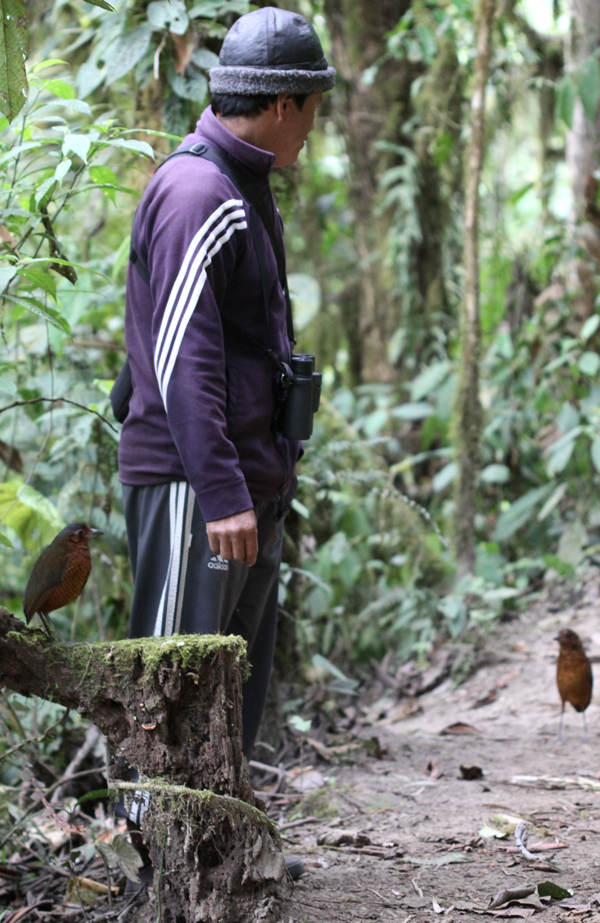 happiness expressed was a magical experience. It was better than seeing my 1,000th bird, better than breaking 300 species in New York in one year, better than self-finding a rarity, better than winning a prize in the Superbowl of Birding. It was the best moment I have ever had while birding. So, yeah, I rank it up there with the seminal moments of my life.
happiness expressed was a magical experience. It was better than seeing my 1,000th bird, better than breaking 300 species in New York in one year, better than self-finding a rarity, better than winning a prize in the Superbowl of Birding. It was the best moment I have ever had while birding. So, yeah, I rank it up there with the seminal moments of my life.
That Angel Paz maintains the trails, keeps the feeders stocked, guides visitors, gets the antpittas to come out, and provides (absolutely delicious) food and drink, all for fifteen American dollars a head, is simply amazing. Of course, the tour companies charge the birders they bring to Refugio Paz de las Aves a whole lot more than what Angel charges them. Angel, after all, just recently got a website up (thanks to Renato), and he does not speak English, which makes it difficult for him to book tourists on his own. He is dependent upon the tour companies to bring him visitors.
The money spent on tour companies by and large leaves Ecuador and serves to enrich folks in the first world. Money spent at Refugio Paz de las Aves directly supports a family that is working to conserve and protect habitat and birds. This is not to say that birders shouldn’t visit Maria through big tour companies. Big tour companies are, after all, how most people find their way to Refugio Paz de las Aves. Birders should, however, be aware that when they visit Refugio Paz de las Aves they are getting an incredible bargain and it certainly wouldn’t hurt to pick up a few souvenirs while they are there. It is often difficult when one is giving money to a conservation cause to ascertain if one’s money is actually going where one hopes for it to go. At the Refugio Paz de las Aves it is abundantly obvious that the money one spends is going directly to someone who has staked his livelihood on preserving habitat and birds. And saving habitat and birds like at the Refugio Paz de las Aves is worth far more than a mere $15.
…


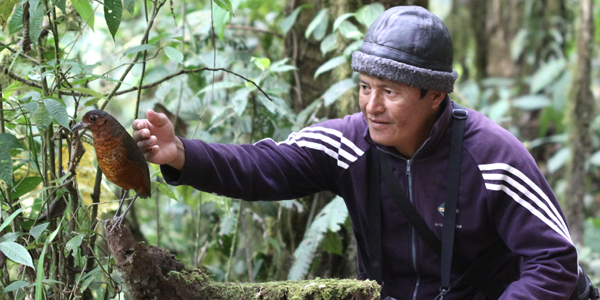
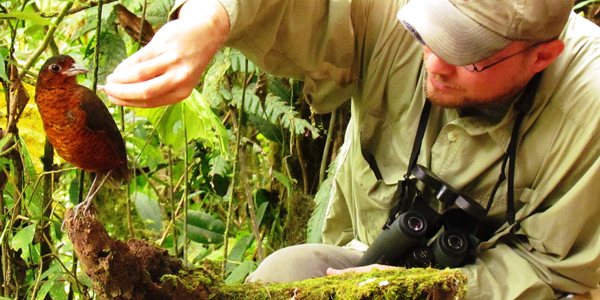
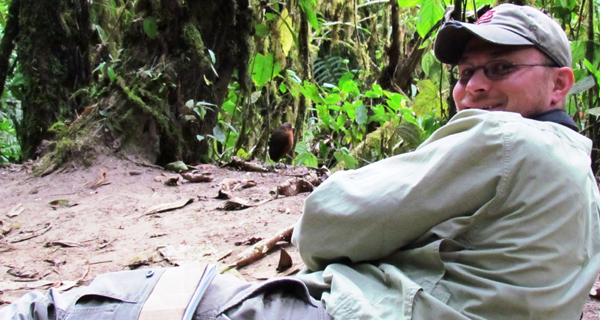











This post makes my heart sing out loud. A seminal post indeed. Corey, you are all heart, and this post proves it. LOVE IT LOVE IT LOVE IT, sharing it sharing it sharing it.
MARIA!! My Maria!
Corey, the happy look on your face says it all. I loved this story.
A beautiful post. If I traveled, I would go and make the acquaintance of Maria. Now I can’t stop singing “Maria… I just met a girl named Maria… And suddenly that name will never be the same to me…”
Didn’t she get the memo? This kind of bird is supposed to be a skulker extraordinaire. A fleeting flimpse of fast moving feathers is all you are supposed to see in a lifetime. You wouldn’t catch a real pitta sitting like that.
Damn I have to see this bird.
Corey, you looked as smitten that morning as Tony does in “West Side Story” when he meets Maria for the first time. I was expecting you to break into song – “I just met a girl named Maria!”
Indeed, we were all enchanted that morning with Maria – how could anyone not be? Hearing her vocalize with apparent contentment just bowled me over.
Angel Paz deserves the highest accolades for what he has done.
I agree 110% that we should support local entrepreneurism whenever possible. That Angel is making a living for his family says it all. Wonderful post!
Maria looks like she is getting plenty to eat. So in love with this bird. What an ambassador for antpittas everywhere.
These little relationships with individual birds are springing up all over the Neotropics. Las Ventanas de Osa on the Pacific coast of Costa Rica has a family of black-and-white owls (usually the very devil to see) that have learned to come to the diving board of their pool for the moths and katydids that the proprietors throw to them. While it could be considered a bit exploitative, the birds are in a sanctuary, as is this antpitta, and thousands of birders who’d never otherwise be lucky enough to see the species benefit from close interaction with them. It’s no different from but infinitely cooler than clustering around a feeding station to see what comes in for the papayas.
What an enchanting story, and wonderful photos!
You lucky devil! When I visited Paz de las Aves, I was able to see Maria on her nest, but did not get the honor of feeding the world’s most beloved antpitta.
Still, like you, I consider my visit to Angel Paz’ avian paradise one of my most memorable and exciting birding moments. What a place!
WOW!!!!
Thank you all for your kind words. May you all meet Maria someday (and, Mike, may you meet her again).
Wow is right Corey. I can’t even imagine how incredible that moment must have been. Being able to observe a vulnerable listed species is one thing, feeding one is quite something else. And then to have Maria thank you in her own words, priceless! Congratulations!
I am so glad to see entrepreneurs anywhere in the world considering ecotourism rather than habitat destruction. Angel should be congratulated and indeed emulated. Obviously if and when I make it to Ecuador, this is where I will go.
I LOVE this story. Thanks, Corey. This past June I went to Ecuador. To Tapichalaca and spent an hour or so watching the Jocotoco Antpitta. Franko learned the art of calling and feeding the Jocotocos from Angel. The day I was there, an adult bird with a young one came to feel. They were only a few feet away from me. An absolutely unforgetable experience.
Cool post Corey. When we went to Refugio Paz de las Aves we did not see Maria but Manuel and he was not nearly as friendly. Still we did get great views. Aside from the Antpittas and mixed flocks we also had great views of a roosting common potoo and Oilbird. I would recommend the place to any birder.
Nice post!
I went and saw Maria back in April.
I guess the Giant Antpitta is the most grabbing and unique headline, but the hand-feeding of Crimson-rumped Toucanets, Black-chinned Mountain-Tanagers, Toucan Barbets, etc. was just as magical to me.
Yes these birds are far easier to see elsewhere (than a giant antpitta), but they are still Choco endemic (almost in the case of the toucanet), brilliantly beautiful and just as friendly as Maria.
Nowhere outside of relatively remote islands (i.e. Galapagos, New Zealand) have I encountered such friendly wild birds.
Just shows that even the most lofty praise for this place ends up understating how phenomenal a bird-watching spot it is!
What a great post, it brought me right back there – Maria, Willie and Carlos – along with all those other fantastic birds. It was a day that made my heart sing and like you said one I’ll never ever forget. And afterwards we had the best breakfast at the site. Angel should be given an award for all his efforts.
What a great story, full of hope and a shining example of success. Bravo to Angel Paz, I hope he will inspire others to preserve their land as well. You do indeed look like a happy guy, Corey – great pic with Ms. Maria, herself. Enjoyed your post!
I like your job! Nice photos. Nice site. I hope you do find your 10000th bird 🙂 best of luck!
If Ecuador has an Angel Paz we also have one in the Philippines that calls a Whiskered Pitta by name. This Pitta species is known to be one if the most difficult to see but through the efforts of Cris our very passionate and dedicated Bird Guide, the Whiskered Pitta is an almost guaranteed sighting in our country. Many families in the community had greatly benefitted from this very successful eco tourism project initiated by one of our most dedicated bird conservationist member Mr. Ramon Quisumbing who also established the BK Valley Bird Sanctuary.